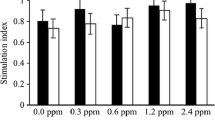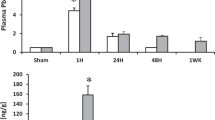Abstract
Mercury (Hg) is a ubiquitous contaminant with deleterious effects on many wildlife species. Most studies to date have focused on fish-eating birds and mammals because much historical Hg pollution is aquatic. Recently, however, comparable blood-Hg levels have been found in terrestrial insectivorous songbirds. As a result, research is needed to clarify the effects of Hg exposure on songbirds. One fundamental end point that is still poorly understood is the effect of Hg on the songbird immune system. If Hg affects the functioning of the immune system, exposed songbirds may be less able to mount an appropriate immune response against invading pathogens. To gain insight into how Hg affects songbird immune function on a cellular level, a flow cytometric assay was developed to measure lipopolysaccharide-induced B-lymphocyte proliferation in zebra finches (Taeniopygia guttata). This is the first experimental (dosing) study of the potential effect of Hg on songbird immune system functioning. Decreased B cell proliferation was observed after lipopolysaccharide exposure in individuals with greater concentrations of Hg in their blood and tissues. In addition, these individuals had decreased ratios of proliferating-to-resting B cells. This decrease in lymphocyte proliferation in response to an effective mitogen suggests that environmental exposure to sublethal levels of Hg may inhibit or delay B cell proliferation in songbirds, potentially increasing susceptibility to disease and decreasing survivorship.




Similar content being viewed by others
References
Adams B, Dorfler P, Aguzzi A, Kozmik Z, Urbfinek P, Maurer-Fogy I et al (1992) Pax-5 encodes the transcription factor Bsap and is expressed in lymphocytes-B, the developing CNS, and adult testis. Gene Dev 6:1589–1607
Barr M, Mott K, Zwollo P (2011) Defining terminally differentiating B cell populations in rainbow trout immune tissues using the transcription factor XbpI. Fish Shell Immunol 6:727–735
Boening DW (2000) Ecological effects, transport, and fate of mercury: a general review. Chemosphere 40:1335–1351
Brasso RL, Cristol DA (2008) Effects of mercury exposure on the reproductive success of tree swallows (Tachycineta bicolor). Ecotoxicology 17:133–141
Brown DL, Reuhl KR, Bormann S, Little JE (1988) Effects of methyl mercury on the microtubule system of mouse lymphocytes. Toxicol Appl Pharmacol 94:66–75
Capella P, Gasparri F, Pulici M, Moll J (2008) A novel method based on click chemistry, which overcomes limitations of cell cycle analysis by classical determination of BrdU incorporation, allowing multiplex antibody staining. Cytometry 73:626–636
Carlson EA, Li Y, Zelikoff JT (2002) Exposure of Japanese medaka (Oryzias latipes) to benzo(a)pyrene suppresses immune function and host resistance against bacterial challenge. Aquat Toxicol 56:289–301
Chehrehasa F, Meedeniya ACB, Dwyer PK, Abrahamsen G, Mackay-Sim A (2009) Edu, a new thymidine analogue for labelling proliferating cells in the nervous system. J Neurosci Methods 177:122–130
Christin MS, Gendron AD, Brousseau P, Ménard L, Marcogliese DJ, Cyr D et al (2003) Effects of agricultural pesticides on the immune system of Rana pipiens and on its resistance to parasitic infection. Environ Toxicol Chem 22:1127–1133
Courrèges MC, Benencia F, Uceda A, Monserrat AJ (2003) Effect of dietary choline deficiency on immunocompetence in Wistar rats. Nutr Res 23:519–526
Cristol DA, Brasso RL, Condon AM, Fovargue RE, Friedman SL, Hallinger KK et al (2008) The movement of aquatic mercury through terrestrial food webs. Science 320:335
Cristol DA, Smith FM, Varian-Ramos CW, Watts BD (2011) Mercury levels of Nelson’s and Saltmarsh sparrows at wintering grounds in Virginia, USA. Ecotoxicology 20:1773–1779
Dalgaard TS, Norup LR, Rubbenstroth D, Wattrang E, Juul-Madsen HR (2010) Flow cytometric assessment of antigen-specific proliferation in peripheral chicken T cells by CFSE dilution. Vet Immunol Immunopathol 15:85–94
Das K, Siebert U, Gillet A, Dupont A, Di-Poï C, Fonfara S et al (2008) Mercury immune toxicity in harbour seals: links to in vitro toxicity. Environ Health Glob 7:52
Day RD, Segars AL, Arendt MD, Lee AM, Peden-Adams MM (2007) Relationship of blood mercury levels to health parameters in the loggerhead sea turtle (Caretta caretta). Environ Health Perspect 115:1421–1428
DeFranco AL, Ashwell JD, Schwartz RH, Paul WE (1982) Frequency of B lymphocytes responsive to anti-immunoglobulin J Exp Med 155:1523–1536
Edmonds ST, Evers DC, Cristol DA, Mettke-Hofmann C, Powell LL, McGann AJ et al (2010) Geographic and seasonal variation in mercury exposure of the declining Rusty Blackbird. Condor 112:789–799
Fallacara DM, Halbrook RS, French JB (2011) Toxic effects of dietary methylmercury on immune system development in nestling American Kestrels (Falco sparverius). Environ Toxicol Chem 30:1328–1337
Finkelstein ME, Grasman KA, Croll DA, Tershy BR, Keitt BS, Jarman WM et al (2007) Contaminant-associated alteration of immune function in black-footed albatross (Phoebastria nigripes), a north pacific predator. Environ Toxicol Chem 26:1896–1903
Frederick P, Jayasena N (2011) Altered pairing behaviour and reproductive success in white ibises exposed to environmentally relevant concentrations of methylmercury. Proc Royal Soc B 278:1851–1857
Gorbsky GJ (2001) The mitotic spindle checkpoint. Curr Biol 11:R1001–R1004
Gorissen L, Snoeijs T, Van Duyse E, Eens M (2005) Heavy metal pollution affects dawn singing behaviour in a small passerine bird. Oecologia 145:504–509
Grasman KA (2002) Assessing immunological function in toxicological studies of avian wildlife. Integr Comp Biol 42:34–42
Haase H, Engelhardt G, Hebel S, Rink L (2011) Mercuric ions inhibit mitogen-activated protein kinase dephosphorylation by inducing reactive oxygen species. Toxicol Appl Pharmacol 250:78–86
Hallinger KK, Cristol DA (2011) The role of weather in mediating the effect of mercury exposure on reproductive success in tree swallows. Ecotoxicology 20:1368–1377
Hallinger KK, Zabransky DJ, Kazmer KA, Cristol DA (2010) Birdsong differs between mercury-polluted and reference sites. Auk 127:156–161
Hammer Ø, Harper DAT, Ryan PD (2001) PAST: Paleontological statistics software package for education and data analysis. Palaeontol Electron 4. http://palaeo-electronica.org
Hasselquist D, Marsh JA, Sherman PW, Wingfield JC (1999) Is avian humoral immunocompetence suppressed by testosterone? Behav Ecol Sociobiol 45:167–175
Hawley DM, Hallinger KK, Cristol DA (2009) Compromised immune competence in free-living tree swallows exposed to mercury. Ecotoxicology 18:499–503
Holmes P, James KAF, Levy LS (2009) Is low-level environmental mercury exposure of concern to human health? Sci Total Environ 408:171–182
Kennedy MW, Nager RG (2006) The perils and prospects of using phytohaemagglutinin in evolutionary ecology. Trends Ecol Evol 21:653–655
Kenow KP, Grasman KA, Hines RK, Meyer MW, Gendron-Fitzpatrick A, Spalding MG et al (2007) Effects of methylmercury exposure on the immune function of juvenile common loons (Gavia immer). Environ Toxicol Chem 26:1460–1469
Lewis CA (2012) Sublethal effects of methyl mercury on the songbird immune response: An experimental study. Master’s thesis, The College of William and Mary, Virginia
Martin LB II, Han P, Lewittes J, Kuhlman JR, Klasing KC, Wikelski M (2006) Phytohemagglutinin-induced skin swelling in birds: histological support for a classic immunoecological technique. Funct Ecol 20:290–299
Miura K, Inokawa M, Imura N (1984) Effects of methylmercury and some metal-ions on microtubule networks in mouse glioma-cells and in vitro tubulin polymerization. Toxicol Appl Pharmacol 73:218–231
Nera KP, Lassila O (2006) Pax5—A critical inhibitor of plasma cell fate. Scand J Immunol 64:190–199
Pheng S, Chakrabarti S, Lamontagne L (2000) Dose-dependent apoptosis induced by low concentrations of methylmercury in murine splenic Fas + T cell subsets. Toxicology 149:115–128
Rimmer CC, Miller EK, McFarland KP, Taylor RJ, Faccio SD (2010) Mercury bioaccumulation and trophic transfer in the terrestrial food web of a montane forest. Ecotoxicology 19:697–709
Salic A, Mitchison TJ (2008) A chemical method for fast and sensitive detection of DNA synthesis in vivo. Proc Natl Acad Sci U S A 105:2415–2420
Scheulhammer AM, Meyer MW, Sandheinrich MB, Murray MW (2007) Effects of environmental methylmercury on the health of wild birds, mammals, and fish. Ambio 36:12–18
Shenker BJ, Datar S, Mansfield K, Shapiro IM (1997) Induction of apoptosis in human T-cells by organomercuric compounds: a flow cytometric analysis. Toxicol Appl Pharmacol 143:397–406
Varian-Ramos CW, Condon AM, Hallinger KK, Carlson-Drexler KA, Cristol DA (2011) Stability of mercury concentrations in frozen avian blood samples. Bull Environ Contam Toxicol 86:159–162
Vinkler M, Bainová H, Albrecht T (2010) Functional analysis of the skin-swelling response to phytohaemagglutinin. Funct Ecol 24:1081–1086
Wada H, Cristol DA, McNabb FM, Hopkins WA (2009) Suppressed adrenocortical responses and thyroid hormone levels in birds near a mercury-contaminated river. Environ Sci Technol 43:6031–6038
Warr GW (1981) Evolution of the lymphocyte. Immunol Today 2:63–68
Yu Y, Arora A, Min W, Roifman CM, Grunebaum E (2009) EdU incorporation is an alternative non-radioactive assay to [3H]thymidine uptake for in vitro measurement of mice T-cell proliferations. J Immunol Methods 350:29–35
Ziemba SE, Mattingly RR, McCabe MJ Jr, Rosenspire AJ (2006) Inorganic mercury inhibits the activation of LAT in T-cell receptor-mediated signal transduction. Toxicol Sci 89:145–153
Zwollo P (2011) Dissecting teleost B cell differentiation using transcription factors. Dev Comp Immunol 35:898–905
Zwollo P, Rao S, Wallin JJ, Gackstetter ER, Koshland ME (1998) The transcription factor NF-kappaB/p50 interacts with the blk gene during B cell activation. J Biol Chem 273:18647–18655
Zwollo P, Cole S, Bromage E, Kaattari S (2005) B cell heterogeneity in the teleost kidney: evidence for a maturation gradient from anterior to posterior kidney. J Immunol 174:6608–6616
Zwollo P, Haines A, Rosato P, Gumulak-Smith J (2008) Molecular and cellular analysis of B-cell populations in the rainbow trout using Pax5 and immunoglobulin markers. Dev Comp Immunol 32:1482–1496
Acknowledgments
This study was funded by E. I. DuPont de Nemours and Company, and research was completed with oversight from the South River Science Team, which is a collaboration of state and federal agencies, academic institutions, and environmental interests. In addition, we thank Dennis Hasselquist for providing us with anti-red-winged blackbird antibody and Margaret Whitney and Margaret Barr for training and logistical support throughout.
Author information
Authors and Affiliations
Corresponding author
Rights and permissions
About this article
Cite this article
Lewis, C.A., Cristol, D.A., Swaddle, J.P. et al. Decreased Immune Response in Zebra Finches Exposed to Sublethal Doses of Mercury. Arch Environ Contam Toxicol 64, 327–336 (2013). https://doi.org/10.1007/s00244-012-9830-z
Received:
Accepted:
Published:
Issue Date:
DOI: https://doi.org/10.1007/s00244-012-9830-z




